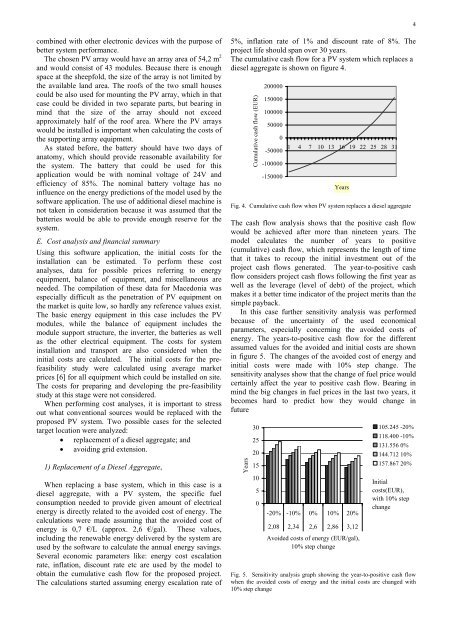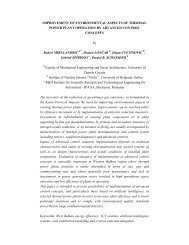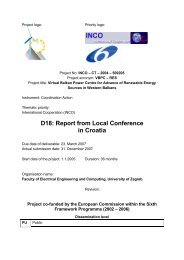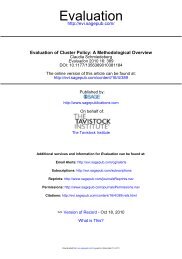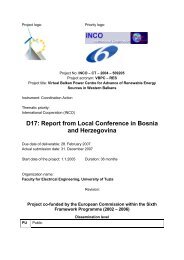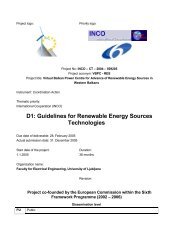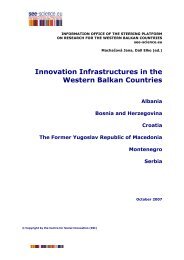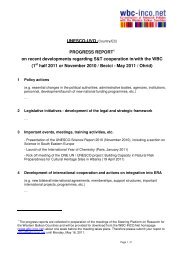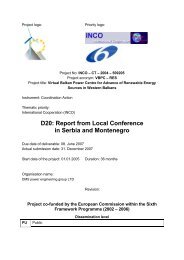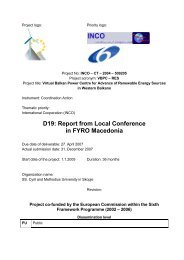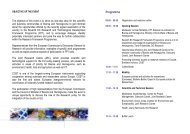Prva stran - WBC-INCO Net
Prva stran - WBC-INCO Net
Prva stran - WBC-INCO Net
Create successful ePaper yourself
Turn your PDF publications into a flip-book with our unique Google optimized e-Paper software.
combined with other electronic devices with the purpose of<br />
better system performance.<br />
The chosen PV array would have an array area of 54,2 m 2<br />
and would consist of 43 modules. Because there is enough<br />
space at the sheepfold, the size of the array is not limited by<br />
the available land area. The roofs of the two small houses<br />
could be also used for mounting the PV array, which in that<br />
case could be divided in two separate parts, but bearing in<br />
mind that the size of the array should not exceed<br />
approximately half of the roof area. Where the PV arrays<br />
would be installed is important when calculating the costs of<br />
the supporting array equipment.<br />
As stated before, the battery should have two days of<br />
anatomy, which should provide reasonable availability for<br />
the system. The battery that could be used for this<br />
application would be with nominal voltage of 24V and<br />
efficiency of 85%. The nominal battery voltage has no<br />
influence on the energy predictions of the model used by the<br />
software application. The use of additional diesel machine is<br />
not taken in consideration because it was assumed that the<br />
batteries would be able to provide enough reserve for the<br />
system.<br />
E. Cost analysis and financial summary<br />
Using this software application, the initial costs for the<br />
installation can be estimated. To perform these cost<br />
analyses, data for possible prices referring to energy<br />
equipment, balance of equipment, and miscellaneous are<br />
needed. The compilation of these data for Macedonia was<br />
especially difficult as the penetration of PV equipment on<br />
the market is quite low, so hardly any reference values exist.<br />
The basic energy equipment in this case includes the PV<br />
modules, while the balance of equipment includes the<br />
module support structure, the inverter, the batteries as well<br />
as the other electrical equipment. The costs for system<br />
installation and transport are also considered when the<br />
initial costs are calculated. The initial costs for the prefeasibility<br />
study were calculated using average market<br />
prices [6] for all equipment which could be installed on site.<br />
The costs for preparing and developing the pre-feasibility<br />
study at this stage were not considered.<br />
When performing cost analyses, it is important to stress<br />
out what conventional sources would be replaced with the<br />
proposed PV system. Two possible cases for the selected<br />
target location were analyzed:<br />
• replacement of a diesel aggregate; and<br />
• avoiding grid extension.<br />
1) Replacement of a Diesel Aggregate,<br />
When replacing a base system, which in this case is a<br />
diesel aggregate, with a PV system, the specific fuel<br />
consumption needed to provide given amount of electrical<br />
energy is directly related to the avoided cost of energy. The<br />
calculations were made assuming that the avoided cost of<br />
energy is 0,7 €/L (approx. 2,6 €/gal). These values,<br />
including the renewable energy delivered by the system are<br />
used by the software to calculate the annual energy savings.<br />
Several economic parameters like: energy cost escalation<br />
rate, inflation, discount rate etc are used by the model to<br />
obtain the cumulative cash flow for the proposed project.<br />
The calculations started assuming energy escalation rate of<br />
5%, inflation rate of 1% and discount rate of 8%. The<br />
project life should span over 30 years.<br />
The cumulative cash flow for a PV system which replaces a<br />
diesel aggregate is shown on figure 4.<br />
Cumulative cash flow (EUR)<br />
200000<br />
150000<br />
100000<br />
50000<br />
0<br />
-50000<br />
-100000<br />
-150000<br />
1 4 7 10 13 16 19 22 25 28 31<br />
Years<br />
Fig. 4. Cumulative cash flow when PV system replaces a diesel aggregate<br />
The cash flow analysis shows that the positive cash flow<br />
would be achieved after more than nineteen years. The<br />
model calculates the number of years to positive<br />
(cumulative) cash flow, which represents the length of time<br />
that it takes to recoup the initial investment out of the<br />
project cash flows generated. The year-to-positive cash<br />
flow considers project cash flows following the first year as<br />
well as the leverage (level of debt) of the project, which<br />
makes it a better time indicator of the project merits than the<br />
simple payback.<br />
In this case further sensitivity analysis was performed<br />
because of the uncertainty of the used economical<br />
parameters, especially concerning the avoided costs of<br />
energy. The years-to-positive cash flow for the different<br />
assumed values for the avoided and initial costs are shown<br />
in figure 5. The changes of the avoided cost of energy and<br />
initial costs were made with 10% step change. The<br />
sensitivity analyses show that the change of fuel price would<br />
certainly affect the year to positive cash flow. Bearing in<br />
mind the big changes in fuel prices in the last two years, it<br />
becomes hard to predict how they would change in<br />
future<br />
Years<br />
30<br />
25<br />
20<br />
15<br />
10<br />
5<br />
0<br />
-20% -10% 0% 10% 20%<br />
2,08 2,34 2,6 2,86 3,12<br />
Avoided costs of energy (EUR/gal),<br />
10% step change<br />
105.245 -20%<br />
118.400 -10%<br />
131.556 0%<br />
144.712 10%<br />
157.867 20%<br />
Initial<br />
costs(EUR),<br />
with 10% step<br />
change<br />
Fig. 5. Sensitivity analysis graph showing the year-to-positive cash flow<br />
when the avoided costs of energy and the initial costs are changed with<br />
10% step change<br />
4


